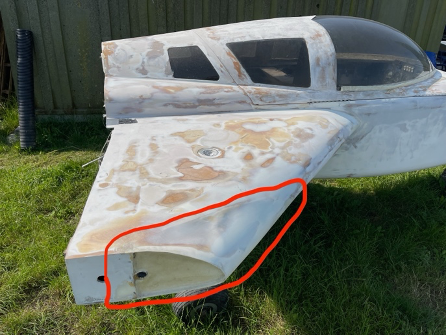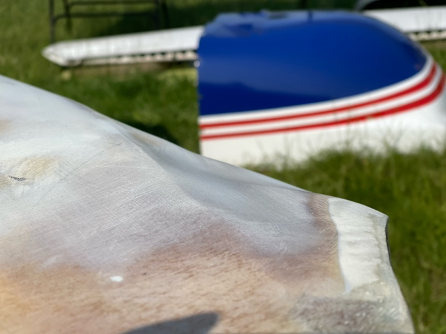LAA Response (2024-02-13)
I previously sent this to the LAA:
Dear LAA Engineering,
I’m in the process of rebuilding a Cozy that last flew in 1998. It was previously repaired following a low-speed impact with a car a few years ago, and from whom I purchased the aircraft.
Unfortunately, since then, the repairs at FS114/BL58 (shown below), and minor repairs to the rear fuselage sides, have deformed. It appears that unsuitable foam was used, as the foam has shrunk, pulling and deforming the fibreglass. The foam is also sponge-like to the touch, rather than rigid styrofoam.
I have removed the deformed fibreglass and foam, and discussed the repair with an LAA inspector. I’m now ready to re-do the repair work as originally described, and continue with the rebuild of the aircraft.
Regarding the repair, the plans call for blue styrofoam to be used, however blue styrofoam has been discontinued - the manufacturer states this is to reduce the global warming potential in its creation. It has been replaced by a similar dark grey foam, which the manufacturer describes as having “the same thermal performance, moisture resistance, durability and ease-of-use”, as well as the same R-value as blue styrofoam.
Q: Has the LAA got an opinion on the use of this dark grey XPS styrofoam in lieu of blue styrofoam?
Q: What additional information, if any, do you require before I begin the repairs, given that I plan to re-do the repair per plans and as detailed in 1070?
Next Steps
Once this repair is complete, I then plan to carry out the following:
- Replace original (seized) nose gear retraction system with an EZ Noselift[^1].
- Addition of:
- Garmin G3X System (PFD + MFD),
- GTN 650 Xi COMM/NAV/GPS,
- GNC 355A COMM/GPS,
- GMC 507 AFCS (autopilot) with pitch & aileron control and pitch & aileron trim servos
- G5 backup instrument (with battery backup, per TL 3.20)
- GTX 45R + GAE 12 Transponder with certified ADS-B Out
- Install Garmin heated (regulated) pitot tube. The original pitot is in the nose, but the new pitot will be installed in under the repaired port wing strake and positioned per Garmin’s installation instructions.
- Install dual-battery, dual-alternator, dual power bus electrical system, based on the system used by the Cirrus SR2x G3, with main bus/ess bus avionics. The batteries will both be EarthX ETX-900 VNT LiFePO4. The system is similar to the Nuckolls Z-14 Dual Battery, Dual > * Alternator, Split Bus system, except rather than using a manual cross-feed switch between buses, it uses a twin 50A diode component and different alternator voltages to allow the Ess Bus to be powered by the main bus alternator (and/or battery) automatically, in case of alternator failure.
- Move fuel selector from behind elbow position in original plans, to the centre console in front of the panel.
- Replace magnetos with dual electric Lightspeed Aero Plasma III[2] ignition system
I plan to submit these mods as I complete them in due course. I also plan that the aircraft will be suitable for night/IFR in the future.
Q: Are there any steps that I should take now to smooth the approval process later? Please can you also let me know if you would like any of the above mod applications to be submitted prior to starting.
I will also be replacing the tyres, brake lines, brake pads, and fuel lines with like-for-like new parts, and replacing the existing landing light with an LED equivalent (in the same location).
To support the avionics, an aluminium panel will be mounted in front of the existing panel. After discussion with my inspector, we both agreed that the structural elements of the panel are two 1” horizontal ribs that run across the cockpit, one immediately above the leg hole, and another just below the top of the panel. Those struts will remain in place. Per Chapter 4, pages 2-3, the existing panel is 0.2” Clark foam with three plies of BID on the forward-facing side, and two plies of BID fibreglass, 1 ply of UND on the rear, cockpit-facing side. Cuts to allow installation of the new avionics will be only as required and kept to the bare minimum.
Q: I don’t believe a mod application will be required for the panel, given the retention of the structural ribs and the materials used for the rest of the panel, but can you confirm you’re happy with this approach please?
Today, the LAA responded:
Your findings are rather disturbing, but fortunately the area in question is non structural and considered as a fairing between the strake and wing. The foam specified, at least in the Long-EZ manual and I expect would be the same in the Cozy manual, can be either Urethane or Styrofoam (2lb/ft^3) and is skinned with 2 crossed plies of UND (92145) cloth overlapping onto the strake. When removing this overlap, care must be taken not to damage the underlying UND strips on the ends of the strakes.
A1. I see no reason for you not to use the currently available XPS Styrofoam in place of the now unavailable blue Styrofoam FB.
A2. Please have the repair preparation and the repair itself inspected and recorded on a worksheet, then send us a copy of the worksheet after it’s been signed by an appropriately approved inspector, please. We would then raise the Repair to Issue 2 to approve your repair.
Nose lift.
Fitting an electric nose lift should be acceptable and straightforward, but would nevertheless require you to submit a mod application for it, please, starting the ball rolling with a Mod 2 form.
Avionics.
You’ve correctly assessed that we’ll need a Mod 7 and Mod 17 for what you propose to do with the avionics.
Auto-pilot.
For an auto-pilot installation, kindly complete and submit a Mod 2 form for this, please, before any servos’ installation work is done.
Heated pitot head.
This is another mod that will require a Mod 2 to be submitted, please.
Electrical system.
For the changes you propose to make to the aircraft’s electrical system, we’ll need yet another Mod 2 from you, please.
For the dual LiFePO4 batteries installation, kindly follow the requirements of Standard Mod 14337, ultimately submitting a Mod 1 form, please.
Fuel selector repositioning.
It won’t surprise you to know by now that we’ll need a Mod 2 form to be submitted for this mod as well, please.
Electronic ignition system.
To round things off, kindly submit a Mod 2 form for this mod as well, please.
A3. As you intend to apply for Night/IFR restriction removal, take a look first at technical leaflets TL2.27 and TL2.28.
A4. Provided that the structural elements for the instrument panel bulkhead remain in place and especially if the new metal panel is structurally affixed to them, then there should be no need to apply for a mod for this.
When the time comes to apply for permit revalidation, please submit a copy of all the worksheets that detail the work done to bring the aircraft back to an airworthy state and the inspections carried out.
In short, there’s a lot to do, but the path forward is there now. Time to start the repairs!

